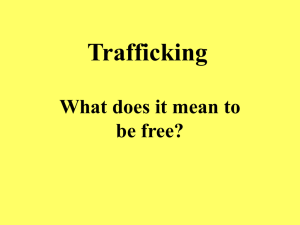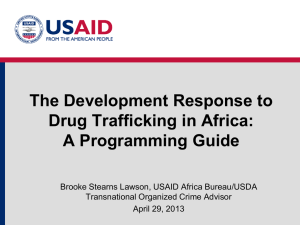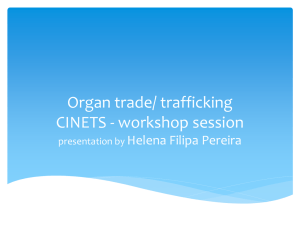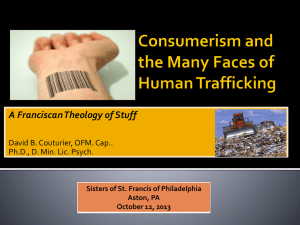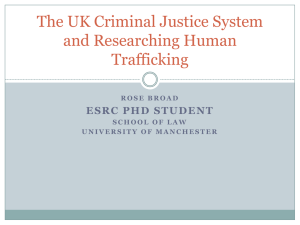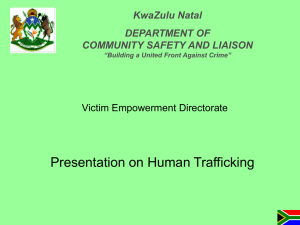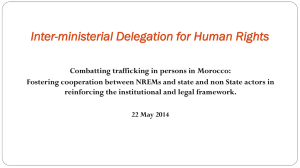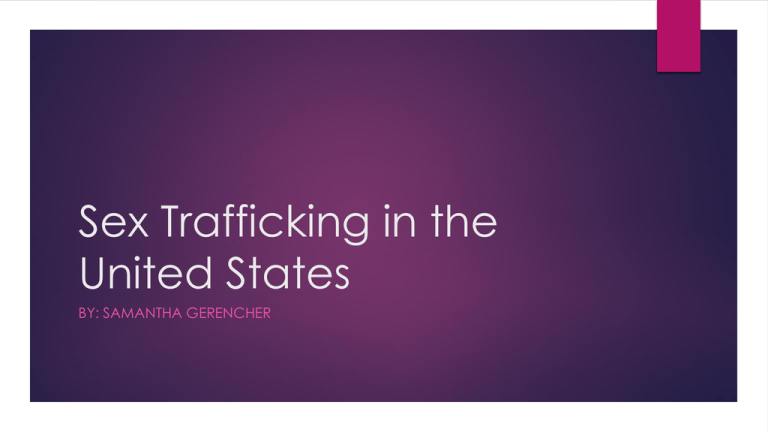
Sex Trafficking in the
United States
BY: SAMANTHA GERENCHER
Sex Trafficking
Sex Trafficking is defined by The Victims of Trafficking and Violence
Protection Act (VTVPA) as
“sex trafficking in which a commercial sex act is induced by force, fraud, or
coercion, or in which the person induced to perform such an act has not
attained 18 years of age; or
the recruitment, harboring, transportation, provision, or obtaining of a person for
labor or services, through the use of force, fraud, or coercion for the purpose of
subjection to involuntary servitude, peonage, debt bondage, or slavery.”
(Kotrla, 1).
Human Rights Issue
The United Nations defines Human rights as “rights inherent to all human
beings, whatever our nationality, place of residence, sex, national or
ethnic origin, colour, religion, language, or any other status. We are all
equally entitled to our human rights without discrimination. These rights are
all interrelated, interdependent and indivisible” (United Nations).
So What?
Sex Trafficking directly violates a persons inherent rights. It strips people of
their ability to make decisions about themselves and their bodies. Sex
trafficking is a large violation of basic human rights.
People that are sold into sex slavery lose control of everything about
themselves. They become degraded and abused.
Sex trafficking directly violates the Declaration of Human Rights
Article 4: “No one shall be held in slavery or servitude; slavery and the slave
trade will be prohibited in all their forms” (General Assembly, Article 4).
Article 5: “No one shall be subjected to torture or to cruel, inhuman, or
degrading treatment or punishment” (General Assembly, Article 5).
My Question is…
What can we do to put an end to the increasing rate of people being sold
into sex slavery?
Statistics
The United States government estimates that approximately 50,000 individuals
are trafficked into the country each year (Holman 2008, p. 104).
The number of people trafficked domestically every year is between 14,500
and 17,500 (Squillante, 229).
Domestic Minor Sex Trafficking (DMST) is defined as “the commercial sexual
abuse of children through buying, selling, or trading their sexual services”
(Kotrla, 182).
It is impossible to get an accurate estimation because of how hidden these
operations are.
“There are currently 100,000 DMST victims in the United States with up to 325,000 more
at risk for becoming such victims” (Kotrla, 182).
Instances of sex and labor trafficking have been reported in all 50 states and
District of Columbia in the past 2 years (Trevelyn).
Causes of Sex Trafficking in the United
States
Supply-Demand
In order for there to be a need to supply trafficked individuals, there first needs
to be a need for them
“anywhere there is "a thriving sex industry exploiters need to generate a supply
for the ravenous market to consume fellow human beings as sex commodities”
(Kotrla, 182).
Force
There are a lot of instances that occur that can lead to forced entering into sex
trafficking
“Some individuals are “drugged, kidnapped, or sold by their own families” to traffickers
who then facilitate slavery” (Schaffner, 1526).
Causes of Sex Trafficking
Deception and Coercion
Many people are lied to about their promised position, sign contracts without
reading the fine print and then are bound to a sex trade agreement
Once individuals are part of the sex trade, their superiors threaten their life or the
lives of the ones they love if they do not do as they are told without any
problems
Lack of repercussions or arrests
“it is the fear of arrest and prosecution for a sex work or trafficking-related crime
that dissuades sex workers from reporting trafficked persons to authorities”
(Grover, Health and Human Rights).
What is currently being done?
The passage of the VTVPA was a large step towards a solution
“Since 2001, the United States has provided more than $295 million to support
anti-trafficking programs in more than 120 countries” (Holman, 110).
Holman also mentions (page 110) that the United States gave $500,251 to the
NGO World Vision to launch an informational campaign at destination spots to
keep U.S. citizens from participating in and supporting sex trading and trafficking
However, the VTVPA is not the most effective way to prevent sex trafficking
It put regulations on the type of victims that could seek refuge.
“[However], [f]or women that escape to the U.S. rather than being trafficked into the
U.S., the VTVPA does not apply” (Squilante, 230).
What is currently being done?
VTVPA
New provisions to the law
“focuses on the elements of typical labor trafficking cases prohibiting “force, threats of
force, physical restraint, or threats of physical restraint,” “threats of serious harm,” or
through “abuse or threatened abuse of law or legal process” when coercing a person
into forced labor” (Schaffner, 1528).
Bills being ratified by United States Government
“The just-passed House Bill 133 adds human trafficking legislation to the law
books, and the bill will now go onto the Senate, which is a step in the right
direction for the state” (Jesionka, What is Being Done to Stop Human
Trafficking?).
While there are still some states that do not have regulations on this issue, Jesionka
points out that Massachusetts made great strides in the protection of victims and
trafficking through the internet a punishable offence.
The Polaris Project
Tier 1: State has passed significant laws to
combat human trafficking, and should
continue to take steps to improve and
implement its laws.
Tier 2 : State has passed numerous laws to
combat human trafficking, and should
take more steps to improve and
implement its laws.
Tier 3 : State has made nominal efforts to
pass laws to combat human trafficking,
and should take major steps to improve
and implement its laws.
(Trevelyn, 2012).
Tier 4 : These states have not made
nominal efforts to enact a basic legal
framework to combat human trafficking,
and should actively work to improve their
laws.
Recommendations
Bales offers some solutions in his book Disposable People
Learn and educate others about the issue of slavery
Join with others that also want to end slavery or to support local organizations or
to help keep businesses stop buying into slavery and to enforce anti-slavery laws
To act and make a donation and to offer our own ideas and solutions to this
issue
Bringing this problem to the publics attention is the most effective way to
end human trafficking
If the population demands that human trafficking be demolished and if we put
pressure on politicians and people that hold positions of power and ability to
change this issue, we can facilitate the abolishment of human sex trafficking
References
Bales, Kevin. “Disposable People: New Slavery in the Global Economy.”
Berkeley, Calif: University of California Press, 1999. Print.
Grover, Anand, Tripti Tandon, and Gabriel Armas-Cardona. "Sex Work and
Trafficking: Can Human Rights Lead Us Out of the Impasse?" Health and
Human Rights Journal. 1 Jan. 2008. Web. 11 Dec. 2014.
<http://www.hhrjournal.org/2014/10/21/sex-work-and-trafficking-canhuman-rights-lead-us-out-of-the-impasse/>.
Holman, Melissa. "The Modern-Day Slave Trade: How The United States Should
Alter The Victims Of Trafficking And Violence Protection Act In Order To
Combat International Sex Trafficking More Effectively." Texas International Law
Journal 44.1/2 (2008): 99-121. Academic Search Complete. Web. 2 Dec. 2014.
Jesionka, Natalie. "What's Being Done to Stop Human Trafficking?" What's Being
Done to Stop Human Trafficking? Daily Muse Inc., 1 Feb. 2013. Web. 8
Dec. 2014. <https://www.themuse.com/advice/whats-being-done-tostop-human-trafficking>.
Kotrla, Kimberly. "Domestic Minor Sex Trafficking In The United States." Social
Work 55.2 (2010): 181-187. Academic Search Complete. Web. 2 Dec.
2014.
References
Schaffner, Jessica E. “Optimal Deterrence: A Law and Economics Assessment
of Sex and Labor Trafficking Law in the United States.” Houston Law
Review. 51.5.(2014):1519-1548. Academic Search Complete. Web. 2. Dec.
2014
Squillante, Diana. "Single, Young Female--Seeking Asylum: The Struggles
Victims Of Sex Trafficking Face Under Current United States Refugee
Law." St. John's Law Review 88.1 (2014): 223-253. Academic Search
Complete. Web. 2 Dec. 2014.
Trevelyn, Laura. "Human Trafficking: How US States Fare." BBC News. New York, 7
Aug. 2012. Web. 9 Dec. 2014. <http://www.bbc.com/news/world-uscanada-19169943>.
UN General Assembly, Universal Declaration of Human Rights, 10
December 1948, 217 A (III), available at:
http://www.refworld.org/docid/3ae6b3712c.html [accessed 2
December 2014]
United Nations. "What Are Human Rights." What Are Human Rights. Web. 2
Dec. 2014.
<http://www.ohchr.org/en/issues/pages/whatarehumanrights.aspx>.

